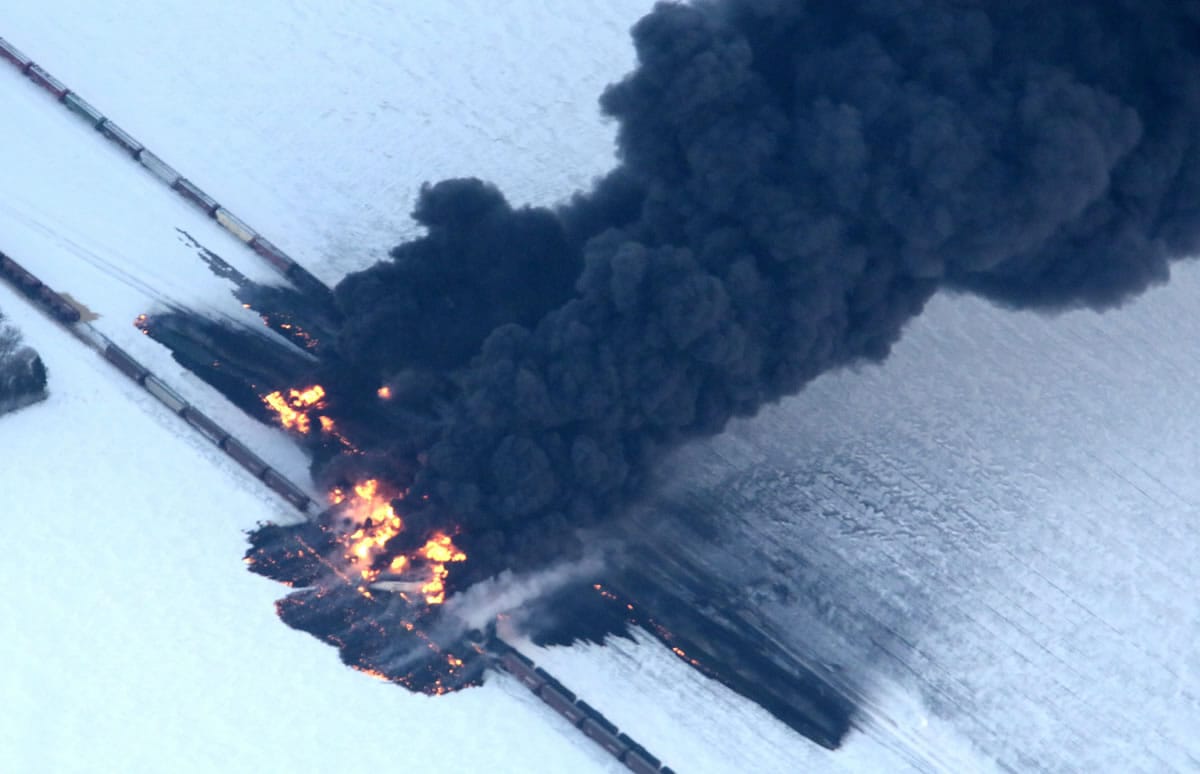CASSELTON, N.D. — A mile-long train carrying crude oil derailed just a mile before it would have cut through the heart of a small North Dakota town, shaking residents with a series of explosions that sent flame and black smoke skyward. No one was hurt, but officials were evacuating as many as 300 people as a precaution.
The mile-long BNSF Railway train left the tracks about 2:30 p.m. Monday, and as many as 10 cars caught fire. They were still burning four hours later as darkness fell, and authorities said they would be allowed to burn out.
Cass County Sheriff’s Sgt. Tara Morris said the evacuation of a section of the town Casselton was a precaution in case of a wind shift. A thick smoke plume from the burning cars was largely staying to the southeast of town. Casselton has about 2,400 residents and is about 25 miles west of Fargo.
Authorities hadn’t yet been able to untangle exactly how the derailment happened, but a second train carrying grain was involved. BNSF spokeswoman Amy McBeth said the train carrying grain derailed first, then knocked several cars of the oil train off adjoining tracks.
Ryan Toop, who lives about a half-mile away, said he heard explosions and drove as close as about two city blocks to the fire, which erupted on a day when temperatures were below zero.
“I rolled down the window, and you could literally keep your hands warm,” Toop said.
The derailment happened amid increased concerns about the United States’ increased reliance on rail to carry crude oil. Fears of catastrophic derailments were particularly stoked after last summer’s crash in Canada of a train carrying crude oil from North Dakota’s Bakken oil patch. Forty-seven people died in the ensuing fire.
The tracks that the train was on Monday pass through the middle of Casselton, and Morris said it was “a blessing it didn’t happen within the city.”
The train had more than 100 cars, and about 80 of them were moved away from the site.
Morris said it could take up to 12 hours before authorities could get close to the fire. The Red Cross set up a temporary shelter at the high school for evacuees. Jeff Zent, a spokesman for Gov. Jack Dalrymple, said the National Guard was on alert if needed.
Casselton’s residents were told to stay indoors as soon as the blasts began.
Hannah Linnard, 13, said she was in the bedroom of her friend’s house about half a mile from the derailment, wrapping late Christmas presents.
“I looked out the window and all of a sudden the train car tipped over and the whole thing was engulfed in flames and it just exploded. The oil car tipped over onto the grain car,” she said. Hannah said she could feel the warmth even inside the house.
Cass County Emergency Manager Dave Rogness said crews called for truckloads of sand to help contain leaking material. The derailment occurred 2 miles from the city’s ethanol plant.
Terry Johnson, the manager of a grain dealer less than a mile from the derailment, said he heard at least six explosions in the two hours following the incident.
“Each one, you could hear the explosion,” he said. “It shook our building and there was a huge fireball.”
Johnson said he was staying inside his grain business, as directed by authorities, but could see the disaster through a window.
“The town is covered with black smoke,” he said. “The wind is blowing a little, so the town doesn’t have to breathe it.”
State health officials were in Casselton and planned to check for health hazards once the fires are out, said Dave Glatt, director of the Health Department’s environmental health section.
“We’re just standing by waiting for emergency responders to get it under control,” he said.
North Dakota is the No. 2 oil-producing state in the U.S., trailing only Texas, and a growing amount of that oil is being shipped by rail. The state’s top oil regulator said earlier this month that he expected as much as 90 percent of North Dakota’s oil would be carried by train in 2014, up from the current 60 percent.
The number of crude oil carloads hauled by U.S. railroads surged from 10,840 in 2009 to a projected 400,000 this year. Despite the increase, the rate of accidents has stayed relatively steady. Railroads say 99.997 percent of hazardous materials shipments reach destinations safely.



